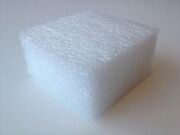PolyPlank

Description
[Pregis] A registered trademark for an extruded Polyethylene foam plank developed specifically for shock-absorption, vibration suppression, insulation & buoyancy in storing and transporting military, computer, and medical equipment, and other precision instruments. PolyPlank is a durable, flexible, closed-cell foam that is water-resistant and impervious to most chemicals. The natural color of polyethylene is bright white with a soft translucence throughout. The sheets/planks have a thin skin of 6 lb. foam on one face that is an unbroken surface but has a bubbly texture with approximately 1mm relief. Despite the absence of additives, the foam feels waxy to the touch.
The edges of the planks expose open cells where they have been broken. Individual cells range between 1-3mm diameter at medium density. Plank edges and other cut surfaces have a rougher texture than that of the closed skin. Both surfaces are generally considered too abrasive for making direct contact with sensitive surfaces, and require the mediation of a smoother material between the PolyPlank and the object, such as Tyvek Softwrap, Volara, or poly-sheeting for a few examples. This mediation can be achieved either by lining the foam or wrapping the object.
PolyPlank, EXT220 and LAM220, appear very similar to Ethafoam 220, another brand name of polyethylene foam, but the two PE foams are manufactured with slightly different methods and chemical compositions. Medium-density PolyPlank has a larger cell structure on average, and the broken cell walls of cut surfaces feel rougher. It offers somewhat less resistance to compression and puncturing than Ethafoam of the same weight. PolyPlank LAM boasts two more light-density options than Ethafoam; 0.9 pcf and 1.2 pcf. [1]
Synonyms and Related Terms
Polyethylene foam; white foam; PE Foam;
Brand names: Ethafoam [Sealed Air Corporation, formerly Dow Chemical Company]; SenFLex [Sentinel Products Corp];
Applications
Typically used in art handling as a shock-absorption and vibration-dampening material (applied in small amounts relative to size of an object):
- Cushioning pads
- Yokes for medium-large rolling tubes or guillotines for moderately sized sculptures
- Thermal insulation (when used as a lining for a container)
Personal Risks
Pregis: SDS
Collection Risks
The natural tint (white) PolyPlank is widely considered chemically stable and suitable for use in preventative conservation [2]
Environmental Risks
PolyPlank should pose no significant hazard to the environment [3] PolyPlank is not cross-linked, so it can be recyclable.
Physical and Chemical Properties
Composition according to SDS:
| Chemical Name | Percent | Composition | CAS No. |
|---|---|---|---|
| Polyethylene resin | ≥ 84 | Ethene/Butene Copolymer
Tris-nonylphenyl phosphite Polyethylene Homopolymer Crystalline silica |
25087-34-7
26523-78-4 9002-88-4 68855-54-9 |
| Hydrocarbon foaming agents | ≥ 5 | Isobutane
n-butane |
75-28-5
106-97-8 |
| Talc | ≥ 4 | Magnesium silicate | 14807-96-6 |
| Foam processing aid | ≥ 2 | Monodiglycerides | 67701-33-1 |
| Organic and/or inorganic colorants | ≥ 5 | Various | Various |
Working Properties
PolyPlank is easily cut with a variety of tools, can be adhered to itself and other polyethylene-based materials with heat welding or hot glue. The 2” material has a useful balance of dimensionality, stiffness, and ease of cutting. Strips/blocks cut from it can be quickly laminated into much thicker cushions as needed.
Common Fabrication Tools according to PACCIN:
- Knife (deli knife, extendable box cutter, specialty foam knife)
- Foam rubber cutter (electric) - For best results, mount cutter under saw table with an adjustable fence
- Hot knife
- Band Saw - For best results, use a scalloped or straight blade
- Table saw - For best results, clean table saw blade frequently
- Heat Gun
- Glue Gun - Suitable with hot-melt or low-melt glue sticks
Forms and Sizes
Information below from PACCIN: PolyPlank Polyethylene Foam.
The most common in art handling is PolyPlank LAM 220, with a relatively medium density of 2.2 lbs/ft^3 in a 2” natural tint(white) sheets at 108x48” or 108x24” planks.
Other Sizes and Densities
Laminated units are available in the following densities:
- PolyPlank LAM090 = 0.9 pcf
- PolyPlank LAM120 = 1.2 pcf
- PolyPlank LAM170 = 1.7 pcf
- PolyPlank LAM220 = 2.2 pcf
They are typically manufactured in 1/2" - 3" thicknesses, and 108 x 48" sheets, but other dimensions can be custom ordered.
PolyPlank EXT is the same formula as PolyPlank LAM, but extruded in one piece rather than laminated, and at a slightly higher price. It is available in the following densities:
- PolyPlank EXT170 = 1.7 pcf
- PolyPlank EXT220 = 2.2 pcf
- PolyPlank EXT400 = 4.0 pcf
- PolyPlank EXT600 = 6.0 pcf
- PolyPlank EXT900 = 9.0 pcf
They are typically manufactured in 2 x 108 x 24" planks, but other dimensions may be available for custom order.
Other Variations
PolyPlank LEL is formulated with less than 10% LEL (low explosive limit) VOC, which meets military and other low residual blowing agent specifications.
PolyPlank Renew is made with 40%-60% pre-consumer recycled material.
PolyPlank SFT is formulated with finer cells for a softer surface texture.
PolyPlank Plus is a custom-ordered system of laminating foam with a variety of substrates, including foil, bubble, adhesive and cohesive films, paper, non-wovens, etc
Resources and Citations
- Pregis PolyPlank Website
- Kaela Nurmi, contributed information, MWG group, 2020.